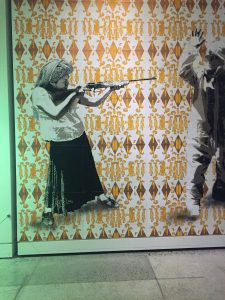The MOA exhibit which I visited for this blog assignment was the “Arts of Resistance” exhibit shown in September. This exhibit, as explained on the MOA website displays “art and performance by artists in Mexico, Guatemala, Peru, El Salvador, Ecuador and Chile, and paying special attention to marginalized communities, this exhibition explores the role of creativity during times of political turmoil.” The pieces which I chose to focus on were by artists in Mexico.
The piece of artwork from the exhibit which I have chosen to focus this reflection on is that displayed as “The Defence of Maize”. This piece of artwork consists of multiple different parts. The first is a graffiti stencil which has multiple layers to it and is split into different segments. The layers are displayed approximately 1-2 feet in front of one another in order to give depth to the piece. The second part is a canvas work which was shown beside the graffiti stencil. The image I have below is that of the canvas. I found the canvas to be most interesting as it included a colourful background unlike the stencil. I specifically enjoyed this collection and furthermore chose to focus on the Defence of Maize portion of the exhibit as I also have some background knowledge of the difficulties Hispanic communities have faced in regard to maize (corn) as well as the important role which it has played in their daily lives and traditions throughout history.

Photo of Canvas in MOA- Arts of Resistance (The Defence of Maize)
When in the exhibit, there was a brief history of the artwork, specifically the stencil shown opposite the works, within this it details that the stencil was “made in 2006, when the city Oaxaca was occupied by the APPO”, however more importantly it give context to the powerful image of the indigenous woman wielding a rifle at the engineers that genetically modified the maize meaning it could be more cheaply sold across markets, however through the degradation of its nutrition (from MOA exhibit). I found this collection within the exhibit to be particularly interesting and I could understand the important of this problem. This further relates to the book “I, Rigoberta Menchu” as on multiple occasions she discusses the importance which Maize plays in her life and the lives of those in the many communities and town which she visits. At one point she even states that “The basis of our culture is maize” (169).
When observing this exhibit, I began to wonder, how does this portrayal of the indigenous people protection of maize given its historical and modern relevance express contemporary political realities? Not only in Maize considered to be the staple of Hispanic, specifically Mexican, diet but it also encompasses close to 7 thousand years of agriculture (articles.latimes). As such the woman represents the indigenous population as a whole (much like Menchu does for her people in her book) and their protection of the maize showcases their protection (and what could also be considered them taking control) over their history. Furthermore, it demonstrates their want to improve their situation. This can be seen from a different perspective if you were to think of the maize in terms of their main source of nutrition and further think of the engineers modifying it as damaging that source. Through this lens you could further hypothesise that by protecting their traditional ways of growing maize, they are not only protecting their history, heritage and traditions but they are furthermore trying to improve their current situation (if you were to assume that the improvement of general health was a symbol of a general improvement in condition)
My final thoughts when viewing this exhibit began to raise some questions on the effect which the “defence of Maize” exhibit had within its originating community. How have these pieces of art been viewed and interpreted by the people who live where these works originate from? Do they have a positive outlook on the impact these works will have and have had?
Links and sources:
http://articles.latimes.com/1992-02-18/news/wr-2329_1_national-heritage
I, Rigoberta Menchu by Rigoberta Menchu
